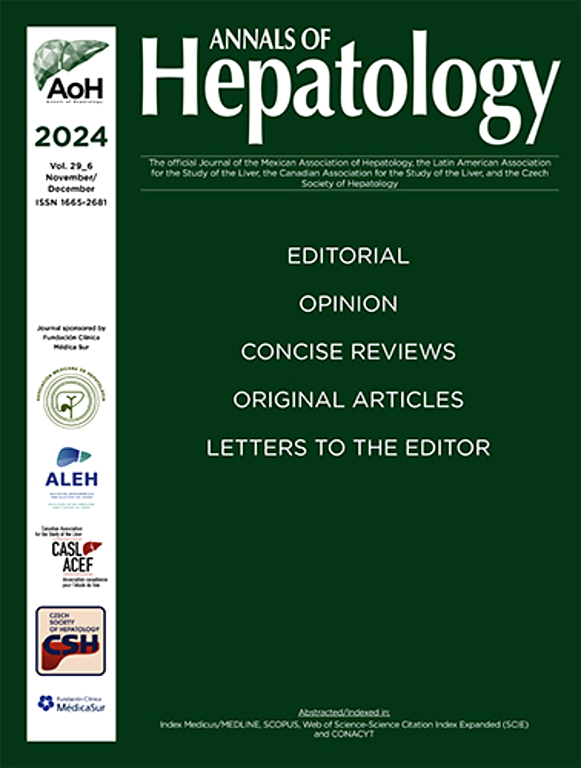Chronic Administration of DEN and 2-AAF for 13 and 18 weeks in Wistar Rats Leads to Progress of Hepatocarcinogenesis
IF 4.4
3区 医学
Q2 GASTROENTEROLOGY & HEPATOLOGY
引用次数: 0
Abstract
Introduction and Objectives
Induction of hepatocellular carcinoma by administration of the agents diethylnitrosamine (DEN) and N-(2-Fluorenyl) acetamide (2-AAF) in murine animals, is a model to study liver cancer. The objective was to evaluate the alterations triggered by the chronic administration of DEN and 2-AAF during 13 and 18 weeks (wks.) in Wistar rats.
Materials and Patients
Male Wistar rats (180-200 g) were organized in groups: a) Control 18 wks. (18-wk Ctl; n=6); b) Damage 18 wks. (18-wk Dmg; n=8), c) Control 13 weeks. (13-wk Ctl; n=5), and d) Damage 13 wks. (13-wk Dmg; n=6). The 13- and 18-wk Dmg groups were weekly treated with i.p DEN (50 mg/Kg) on day one and with i.g. 2-AAF (25 mg/Kg) on day three; the treatment (Tx) was maintained over 13 and 18 weeks, respectively. Then, livers and serum were collected for histological, serum biochemistry, and gene expression analyses. Statistical test Student's t-tests or Kruskal-Wallis and Mann-Whitney U were performed using the software GraphPad Prism version 8. A p value < 0.05 was considered significant.
Results
The rat's survival decreased to 62.5% with the Dmg Tx for the 18-wk Dmg group at the tenth week, but when the 13-wk Dmg group was included, the survival increased to 78.5% (n= 14) until the thirteenth week. Dmg Tx tended to decrease the animal's weight and induced changes in the liver tissue (paler coloration, differentiated nodules, and hepatomegaly; to a lesser degree in the 13-wk Dmg group). Heterogeneity in the damage severity was detected among the animals of both groups, which was also found at the histological level, where there were clear signals of loss of normal hepatocyte architecture, lobular structure disorder, atypical cell enhancement, and accumulation of collagen. Probable lung metastasis was recognized in the 18-wk Dmg group (indicated by macroscopic and histological alterations). In the Dmg groups, the levels of ALT, AST, ALKP, GGT, and total proteins in serum were significantly altered; as well as CAT, SOD, COL1A, and TGFB1 expression were significantly different. In addition, IL6 was also increased in the 18-wk Dmg group.
Conclusions
Dmg Tx during 13 wks. is sufficient to induce significant alterations and the 18-wk Tx exhibited possible lung metastasis. The heterogeneity in this model may be seen as a disadvantage; yet, this may be taken as a depiction of the heterogeneity found in liver cancer patients in real life.
Wistar大鼠慢性给药DEN和2-AAF 13周和18周可导致肝癌发生进展
前言与目的二乙基亚硝胺(DEN)和N-(2-氟烯基)乙酰胺(2-AAF)诱导小鼠肝癌是研究肝癌的一种模型。目的是评估Wistar大鼠在13周和18周长期给药DEN和2-AAF所引发的改变。材料与患者:将Wistar小鼠(180 ~ 200 g)分为各组:a)对照组18周。(18-wk Ctl;n = 6);b)损坏18周。(18-wk Dmg;n=8), c)对照组13周。(13-wk Ctl;n=5), d)损伤13周。(13-wk Dmg;n = 6)。13和18周Dmg组在第1天每周ig DEN (50 mg/Kg),第3天ig 2-AAF (25 mg/Kg);治疗(Tx)分别维持13周和18周。然后,收集肝脏和血清进行组织学、血清生化和基因表达分析。统计学检验采用GraphPad Prism version 8软件进行Kruskal-Wallis和Mann-Whitney U的学生t检验。A p值<;0.05被认为是显著的。结果18周Dmg组大鼠的存活率在第10周降至62.5%,而13周Dmg组大鼠的存活率在第13周上升至78.5% (n= 14)。Dmg Tx倾向于降低动物的体重并引起肝脏组织的变化(颜色变白、分化结节和肝肿大;在13周的Dmg组中程度较低)。两组动物的损伤程度存在异质性,在组织学水平上也发现了这一点,肝细胞正常结构丧失,小叶结构紊乱,非典型细胞增强,胶原蛋白积累等明显信号。在18周的Dmg组中发现可能的肺转移(通过宏观和组织学改变显示)。Dmg组血清ALT、AST、ALKP、GGT及总蛋白水平显著改变;CAT、SOD、COL1A、TGFB1表达差异有统计学意义。此外,18周Dmg组il - 6也有所升高。结论:13周内服用mg Tx。足以引起显著的改变,18周的Tx表现出可能的肺转移。这种模式的异质性可能被视为一种劣势;然而,这可能被认为是对现实生活中肝癌患者异质性的描述。
本文章由计算机程序翻译,如有差异,请以英文原文为准。
求助全文
约1分钟内获得全文
求助全文
来源期刊

Annals of hepatology
医学-胃肠肝病学
CiteScore
7.90
自引率
2.60%
发文量
183
审稿时长
4-8 weeks
期刊介绍:
Annals of Hepatology publishes original research on the biology and diseases of the liver in both humans and experimental models. Contributions may be submitted as regular articles. The journal also publishes concise reviews of both basic and clinical topics.
 求助内容:
求助内容: 应助结果提醒方式:
应助结果提醒方式:


